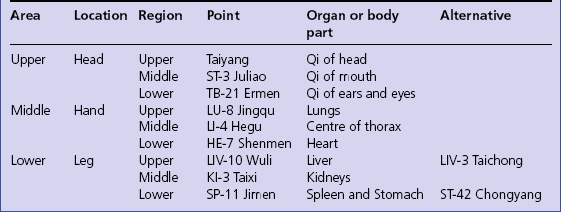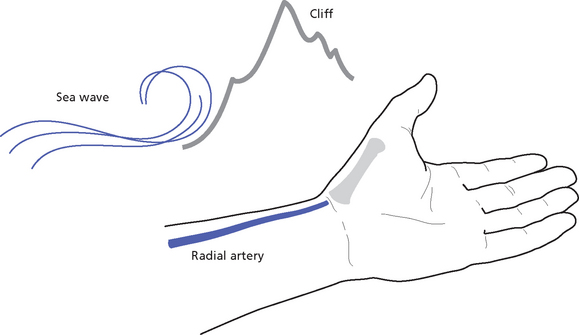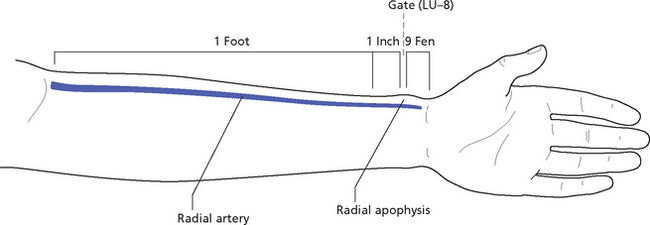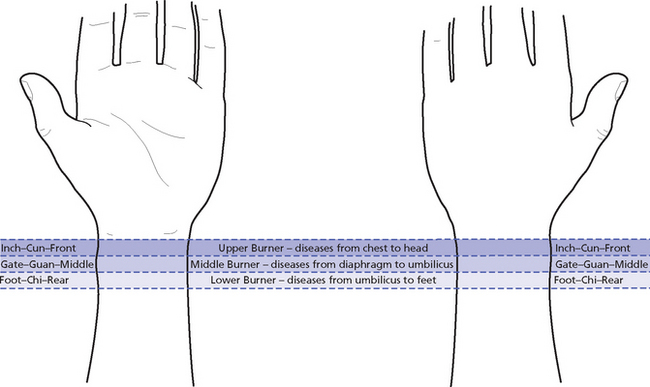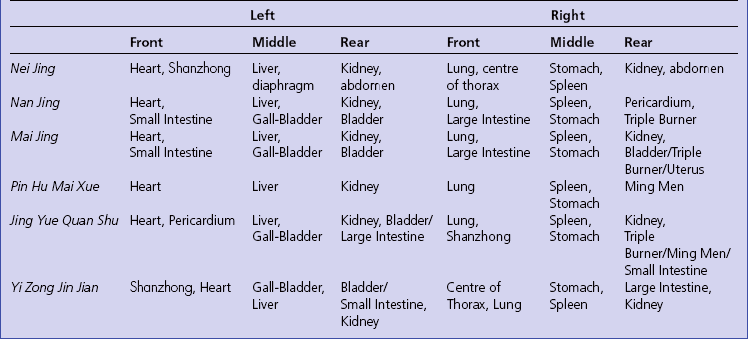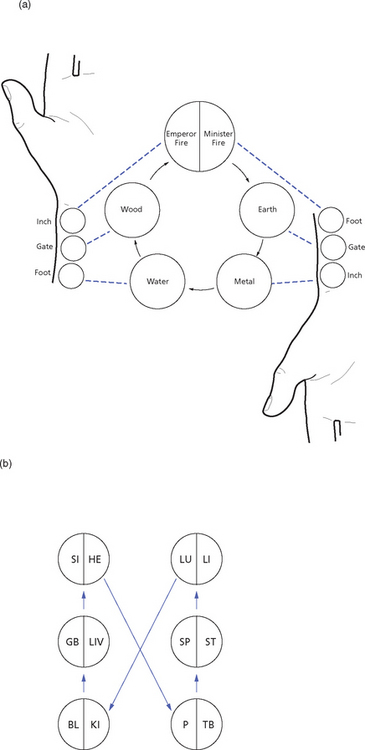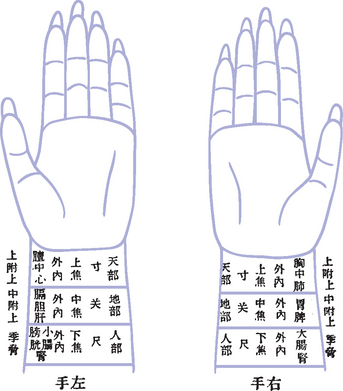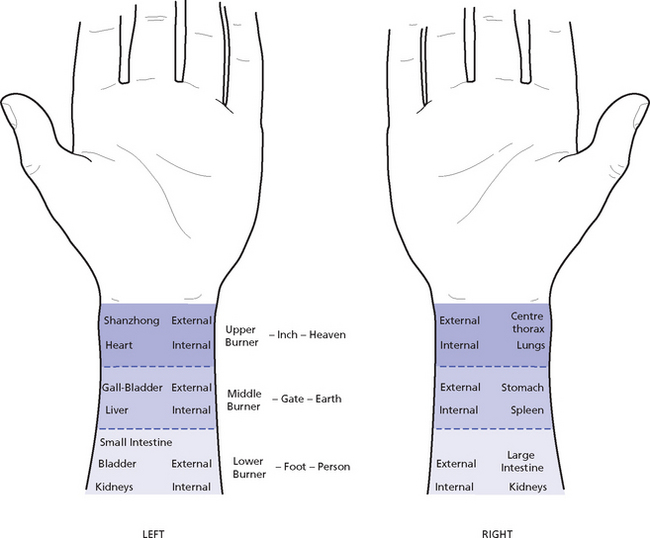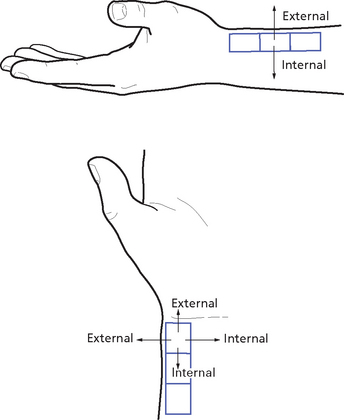Chapter 49 THE ‘NINE REGIONS’ OF THE PULSE FROM THE ‘YELLOW EMPEROR’S CLASSIC OF INTERNAL MEDICINE’ THE PULSE IN THE ‘CLASSIC OF DIFFICULTIES’ THE THREE SECTIONS OF THE PULSE ASSIGNMENT OF PULSE POSITIONS TO ORGANS ATTRIBUTES OF THE NORMAL PULSE GUIDELINES FOR INTERPRETING THE PULSE Feeling the pulse as a whole with three fingers Feeling the spirit, Stomach-Qi and root Feeling the three positions together first and then individually Feeling the overall quality of the pulse, if there is one Feeling the pulse quality, strength and level of each individual position by rolling and pushing the fingers CLINICAL APPLICATION OF PULSE DIAGNOSIS The pulse is often crucial in clinching a diagnosis The pulse is essential to distinguish Deficiency from Excess The pulse is essential to determine the treatment principle The pulse in emotional problems The pulse as an indicator of an organ problem The pulse as an indicator of a heart problem The pulse does not necessarily reflect all the aspects of a disharmony The pulse indicates disharmonies beyond the presenting patterns The pulse can indicate an underlying Deficiency in the absence of symptoms INTEGRATION OF PULSE AND TONGUE DIAGNOSIS LIMITATIONS OF PULSE DIAGNOSIS Pulse diagnosis is the most difficult of the Chinese diagnostic arts: it is a very complex subject which must involve a deep level of understanding and a great deal of skill. An essential diagnostic tool for all practitioners of Chinese medicine, pulse diagnosis is truly an ‘art’; it has more right to that title than any other of the Chinese diagnostic skills. To acquire the skills of good pulse diagnosis requires great patience and to become proficient takes years of practice. It is a study that has no end: one will continue to develop one’s skills and understanding of pulse diagnosis throughout a lifetime of practice. The practice of feeling the pulse on the radial artery was described in the ‘Classic of Difficulties’ (c. AD100); before that, the pulse was taken on nine different arteries: three in the head, three on the hands and three in the legs, as described in Chapter 20 of the ‘Simple Questions’: ‘There are three areas in the body, each area is divided into three which makes nine regions: these are used to determine life and death [i.e. prognosis], and in them, 100 diseases manifest, Deficiency and Excess are regulated and the pathogenic factors can be expelled.’1 The ‘nine regions’ are the arteries where the pulse is felt and which reflect the state of the Upper, Middle and Lower Burners; each of these three areas is divided into three regions identified with Heaven, Person and Earth to indicate Upper, Middle and Lower regions as indicated in Table 49.1. The 12 main channels have their own arteries but the pulse can be taken only at the Portal of Inch [LU-9 position] reflecting the life and death of the 5 Yin and 6 Yang organs … The Portal of Inch is the beginning and end point of the energy of the 5 Yin and 6 Yang organs and that is why we can take the pulse at this position only.2 There are two main reasons why the pulse is felt at the ‘Qi Portal’ position on the radial artery by the wrist in correspondence with the Lung channel. First of all, the Lungs govern Qi and this channel is therefore the best to gauge the state of Qi in the body. In fact, Chapter 1 of the ‘Classic of Difficulties’ says: Twelve channels have places where a pulse can be felt and yet one selects only the Inch Portal to determine the state of the 5 Yin and 6 Yang organs, why is this? The Inch Portal constitutes the great meeting place of the vessels, it is the place where the pulse of the Hand Greater Yin [Lungs] beats … the Inch Portal is the beginning and end of the 5 Yin and 6 Yang organs and therefore only the Inch Portal is used [for diagnosis].3 Secondly, Postnatal Qi and Blood are derived from food and water entering the Stomach. The Stomach extracts the essences of food, which go to the Lungs; from the Lungs, they go to the skin and the five Yin and six Yang organs and to all the arteries in the body; this is a reason why LU-9 Taiyuan is the Gathering point of all blood vessels. The ‘Simple Questions’ says in Chapter 11: The Yellow Emperor asked: why is it that one can tell the state of the 5 Yin organs only from the Qi Portal? Chi Po replied: the Stomach is the Sea of Food and Drink and the great origin of the 6 Yang organs. The five flavours enter the mouth and are stored in the Stomach which nourishes the Qi of the 5 Yin organs; the Qi Portal is the Greater Yin. The flavours of the 5 Yin and 6 Yang organs are all derived from the Stomach and then transformed to become visible at the Qi Portal.4 Chapter 21 of the same text says: The Qi of food enters the Stomach, Food-Qi goes to the Heart and its refined part enters the vessels, the Qi of the vessels flows into the 12 channels and the Qi of the channels reaches the Lungs. The Lungs govern all vessels and their refined essence goes to the skin and body hair. The body hair and vessels combine together and Qi is transmitted to the 6 Yang organs whose Qi is manifested and nourishes the four Yin organs [apart from the Heart]. When Qi is in balance, the Qi Portal becomes the Inch Portal [i.e. the pulse position] from which the state of the body can be determined.5 Thus, the section of radial artery on the Lung channel can tell us about the state of Qi and Blood of the whole body (Box 49.1). Dr J. H. F. Shen has an interesting further idea why the pulse is felt at the radial artery by the wrist. He compares the blood flowing in the radial artery by the wrist with a sea wave and the metacarpal bone of the thumb with a cliff: because the wave of blood in the radial artery crashes against the cliff and is pushed back, we can feel the pulse here. If the blood did not encounter this obstacle, it would flow through undeflected and we would not be able to interpret it in the same way (Fig. 49.1). The three pulse sections are as follows: The Foot and Inch sections of the pulse are the meeting point of the channels. The distance from the Gate position [LU-8, level with the radial apophysis] to the Foot position in the elbow represents the Foot-Interior and it reflects the Yin energies. The distance from the Gate position to the point Fish Margin [the thenar eminence] is the Foot-Exterior and it reflects the Yang energies. Hence, the distance of 1 inch is separated from the distance of 1 foot [from the Gate position to the elbow crease], so that the distance of 1 foot is represented by 1 inch. Hence the Yin energies are reflected within that 1-inch section of the foot-long section and the Yang energies are reflected within a 9-fen [nine-tenths of an inch] section of the Inch section. The total length of the Foot and Inch section extends over 1 inch and 9 fen; hence one speaks of Foot and Inch sections.6 In other words, the distance from the Gate-Guan (or Middle) position of the pulse (on LU-8 Jingqu) to the crease of the elbow measures one Chinese foot and reflects the Yin energies; the distance from the Gate-Guan position to the crease of the wrist is 9 fen (nine-tenths of an inch) and reflects the Yang energies. However, a 1-inch section is separated from the 1-foot distance from the Gate-Guan position to the elbow crease to represent the Yin energies; in other words, this 1-inch section is representative of the 1-foot section (Fig. 49.2). The ‘Pulse Classic’ says something similar: From the Fish Margin [the thenar eminence] to the prominent bone [the radial styloid process] moving one inch backwards [proximally], in the middle of this is the Inch Portal. From the Inch to the Foot, it is called Chi Ze and this position is called Foot. The position behind the Inch and in front of the Foot positions, is called Gate position: this is the boundary between the emerging Yang [at the Inch position] and submerging Yin [at the Foot position]. Emerging Yang occupies three divisions [positions] and submerging Yin also occupies three divisions [positions]. Yang originates at the Foot position and moves [or manifests] in the Inch position; Yin originates in the Inch position and moves [or manifests] in the Foot position. The Inch position governs the Upper Burner including the skin and hair up to the hands; the Gate position governs the Middle Burner including the abdomen and back; the Foot position governs the Lower Burner including the lower abdomen up to the feet.7 The ‘Classic of Difficulties’ says in Chapter 3: ‘In front [i.e. distal] of the Gate position Yang moves, the pulse here is 9 fen long and superficial … behind [i.e. proximal to] the Gate position Yin moves, the pulse here is 1 cun long and is deep.’.8 Thus, three sections of the pulse are identified: the Inch-Cun (Front) section reflecting the Yang energies, and the Gate-Guan (Middle) section and the Foot-Chi (Rear) section reflecting the Yin energies, (Box 49.2). Chapter 18 of the ‘Classic of Difficulties’ describes the three different pressures applied to the pulse: There are three sections, Inch, Gate and Foot, and three pressures, superficial, middle and deep [which makes] 9 regions. The Upper section pertains to Heaven and reflects diseases from the chest to the head; the Middle section pertains to Person and reflects diseases from the dia-phragm to the umbilicus; the Lower section pertains to Earth and reflects diseases from the umbilicus to the feet. [One must] examine [these sections] before needling.9 This passage establishes clearly the principle, adopted by all successive doctors, that the Inch section of the pulse corresponds to the Upper Burner and diseases from the chest upwards, the Gate section to the Middle Burner and diseases from the diaphragm tothe umbilicus, and the Foot section to the Lower Burner and diseases from the umbilicus to the feet (Fig. 49.3). Besides attributing the three sections of the pulse to the Three Burners, Chinese pulse diagnosis goes much further in assigning each pulse position to the Qi of a particular organ. Through the centuries, Chinese doctors have disagreed over such assignment and many different opinions exist. Table 49.2 summarizes the assignment of pulse positions to various organs, according to six representative major classics: Chapter 18 of the ‘Classic of Difficulties’ explains the correspondence of pulse positions to organs (or channels) in accordance with the five Elements in a rather complex statement: The Hand Greater Yin [Lungs] and the Hand Bright Yang [Large Intestine] pertain to Metal; the Foot Lesser Yin [Kidneys] and Foot Greater Yang [Bladder] pertain to Water. Metal generates Water, Water flows downwards and cannot ascend. Therefore, these are felt at the position below the Gate position [i.e. Foot position]. The Foot Terminal Yin [Liver] and the Foot Lesser Yang [Gall-Bladder] pertain to Wood; Wood generates the Fire of the Hand Greater Yang [Small Intestine] and Hand Lesser Yin [Heart]. Fire blazes upwards and cannot descend. Hence, the Hand Greater Yang [Small Intestine] and Hand Lesser Yin [Heart] correspond to the position above the Gate [i.e. the Inch position]. The Fire of the Hand Heart Master [i.e. Pericardium] and Lesser Yang [Triple Burner] generates the Earth of Foot Greater Yin [Spleen] and Foot Bright Yang [Stomach], Earth governs the Centre and its position is therefore the central one. This is in accordance with the Five-Element Mother–Child mutual generating and nourishing relationship.10 Thus, the ‘Classic of Difficulties’ assignment of organs to pulse positions follows strictly the Generating cycle of the Five Elements as follows (Fig. 49.4): The ‘Pulse Classic’ discusses the correspondence of pulse positions to organs (or channels) in Chapter 7. It says: The Heart position is assigned to the left Cun [which is] distal to the Gate position. The Heart is the Hand Lesser Yin and is exteriorly–interiorly related to the Hand Great Yang, i.e. the Small Intestine. The Liver position is assigned to the left gate position. The Liver is the Foot Terminal Yin and is exteriorly–interiorly related to the Foot Lesser Yang, i.e. the Gall-Bladder. The Kidneys position is assigned to the left Foot position which is proximal to the Gate position. The Kidneys are the Foot Lesser Yin which is exteriorly–interiorly related with the Foot Greater Yang, i.e. the Bladder. The Lungs position is assigned to the right Cun position, distal to the Gate position. The Lungs are the Hand Greater Yin and are exteriorly–interiorly related to the Hand Bright Yang, i.e. the Large Intestine. The Spleen position is assigned to the right Guan position. The Spleen is the Foot Greater Yin which is exteriorly–interiorly related to the Foot Bright Yang, i.e. the Stomach. The Kidneys position is assigned to the right Foot position, proximal to the Gate position. The Kidneys are the Foot Lesser Yin which is exteriorly–interiorly related to the Foot Greater Yang, i.e. the Bladder. The Kidneys and Bladder meet in the Lower Burner at a point to the right of Guan Yuan [Ren-4]: to the left of this point are the Kidneys, to the right the Uterus also called Triple Burner.11 The association between Uterus and Triple Burner is interesting as it confirms the statement from Chapter 66 of the ‘Classic of Difficulties’, according to which the Original Qi stems from the space between the two kidneys (and therefore also the Uterus in women) and it spreads to the five Yin and six Yang organs via the intermediary of the Triple Burner. The ‘Study of the Pulse from Pin Hu Lake’ assigns only the Yin organs to the pulse positions: The ‘Golden Mirror of Medicine’ by Wu Qian assigns the pulse positions to the organs as follows: Figure 49.5 is a reproduction of the diagram from the original text and Figure 49.6 is a translation of the same.13 The diagram from the ‘Golden Mirror of Medicine’ clearly shows that ‘external’ and ‘internal’ mean distal and proximal respectively: this means that the Yang and Yin organs within each position are felt at the distal and proximal ends respectively. This is discussed in greater depth below. The most common pulse assignment in modern China is as follows: Such assignment of pulse positions to organs is something that I have deduced from the various teachers I learned with in China as modern books do not usually present this information in a clear form. This is probably due to the fact that there has been considerable disagreement on this over the centuries and modern books tend therefore to gloss over this. For example, ‘Chinese Acupuncture and Moxibustion’ of 1987 does not even give any assignment of pulse positions to organs.14 Other texts often overlook the assignment of the Small and Large Intestine organs as this is the subject of more disagreement: for exam-ple, the ‘Fundamentals of Chinese Medicine’ (a translation of a Chinese text) of 1985 says: ‘The right Inch pulse is associated with the Lungs, and the right Barrier pulse is associated with the Stomach and Spleen. The left Inch pulse is associated with the Heart, and the left Barrier pulse is associated with the Liver and Gall-Bladder. The Kidney and Bladder are reflected in both Cubit pulses.’15 The first interpretation is by far the most common today but it is important to realize that it is not the only one and also that the three interpretations are not mutually exclusive. Indeed, Dr J. H. F. Shen often uses the second and third interpretations when reading the pulse; this will be discussed later. Figure 49.7 illustrates the three different ways of interpreting ‘external’ and ‘internal’. In any case, the relationship between Yin and Yang organs as reflected on the pulse needs to be interpreted dynamically and not mechanically; we should not simply assign the superficial level to the Yang organs and the deep level to the Yin ones, for example on the left Middle position the Gall-Bladder on the superficial level and the Liver on the deep level. As the relationship between the paired Yin and Yang organs is very close (except for the Small Intestine/Heart and Large Intestine/Lung, which will be discussed shortly), each individual pulse position should be first analysed as a whole, paying attention to the intensity and the level of the pulse, rather than mechanically feeling the ‘Gall-Bladder’ on the superficial level and the ‘Liver’ on the deep level as two separate entities. The pulse essentially reflects the state of Qi in the different Burners and at different energetic levels which are dependent on the pathological condition. We need to interpret the pulse dynamically rather than mechanically. The most important thing is to appraise how Qi is flowing, what is the relationship between Yin and Yang on the pulse (i.e. is there Deficiency or Excess of Yin or Yang), at what level is Qi flowing (i.e. is the pulse superficial or deep), and whether the body’s Qi is deficient and whether there is an attack by an external pathogenic factor.
 PULSE DIAGNOSIS
PULSE DIAGNOSIS
INTRODUCTION
THE ‘NINE REGIONS’ OF THE PULSE FROM THE ‘YELLOW EMPEROR’S CLASSIC OF INTERNAL MEDICINE’
THE PULSE IN THE ‘CLASSIC OF DIFFICULTIES’
THE THREE SECTIONS OF THE PULSE
Inch (Cun)
Front
Gate (Guan)
Middle
Foot (Chi)
Rear
ASSIGNMENT OF PULSE POSITIONS TO ORGANS
Organ positions on the pulse
Classic of Difficulties (Nan Jing, AD100)
Left
Right
Small Intestine/Heart
Lungs/Large Intestine
Gall-Bladder/Liver
Spleen/Stomach
Bladder/Kidneys
Pericardium/Triple Burner
Pulse Classic (Mai Jing, AD280)
Left
Right
Small Intestine/Heart
Lungs/Large Intestine
Gall-Bladder/Liver
Spleen/Stomach
Bladder/Kidneys
Kidneys/Uterus/Triple Burner/Bladder
The ‘Study of the Pulse from Pin Hu Lake’ (Pin Hu Mai Xue, 1564)
The ‘Golden Mirror of Medicine’ (Yi Zong Jin Jian, 1742)
Left
Right
‘External’/‘Internal’
‘Internal’/‘External’
Shanzhong/Heart
Lungs/Centre of thorax
Gall-Bladder/Liver
Spleen/Stomach
Bladder, Small Intestine/Kidneys
Kidneys/Large Intestine
Modern China
Left
Right
‘External’/‘Internal’
‘Internal’/‘External’
Pericardium/Heart
Lungs
Gall-Bladder/Liver
Spleen/Stomach
Small Intestine/Bladder/Kidney-Yin
Kidney-Yang/Large Intestine
Reconciling different pulse arrangements
Yin and Yang organ as reflected on the pulse
Clinical significance of pulse diagnosis irrespective of organ positions
![]()
Stay updated, free articles. Join our Telegram channel

Full access? Get Clinical Tree


PULSE DIAGNOSIS

